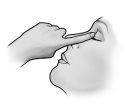
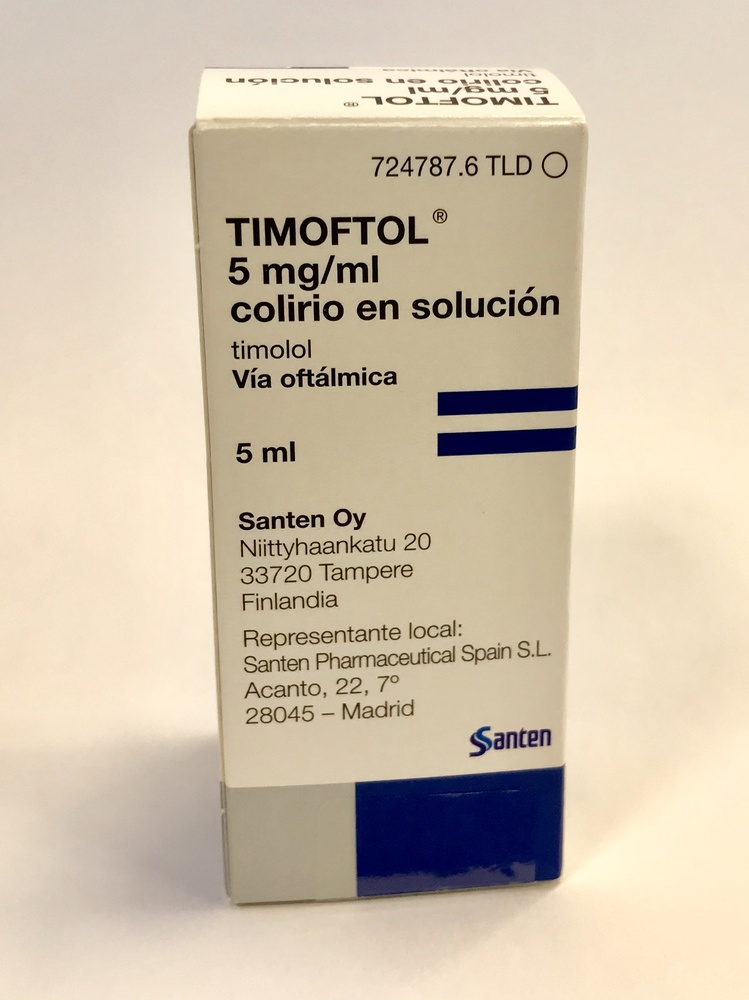
ТИМОФТОЛ 5 мг/мл КРАПЛІ ОЧНІ, РОЗЧИН

Запитайте лікаря про рецепт на ТИМОФТОЛ 5 мг/мл КРАПЛІ ОЧНІ, РОЗЧИН

Інструкція із застосування ТИМОФТОЛ 5 мг/мл КРАПЛІ ОЧНІ, РОЗЧИН
Введення
Про інструкцію: інформація для користувача
ТИМОФТОЛ 5 мг/мл офтальмологічний розчин
Тимолол
Перш ніж почати використовувати цей лікарський засіб, уважно прочитайте цю інструкцію, оскільки вона містить важливу інформацію для вас.
- Збережіть цю інструкцію, оскільки вам може знадобитися знову її прочитати.
- Якщо у вас виникли питання, проконсультуйтеся з вашим лікарем або фармацевтом.
- Цей лікарський засіб призначений тільки вам, і не передавайте його іншим людям, навіть якщо вони мають相同ні симптоми, оскільки це може їм нашкодити.
- Якщо ви відчуваєте побічні ефекти, проконсультуйтеся з вашим лікарем або фармацевтом, навіть якщо це побічні ефекти, які не вказані в цій інструкції. Див. розділ 4.
Зміст інструкції
- Що таке ТИМОФТОЛ і для чого він використовується
- Що потрібно знати перед початком використання ТИМОФТОЛ
- Як використовувати ТИМОФТОЛ
- Можливі побічні ефекти
- Збереження ТИМОФТОЛ
- Зміст упаковки та додаткова інформація
1. Що таке ТИМОФТОЛ і для чого він використовується
Тимофтол - це офтальмологічний бета-блокувальник, який належить до групи лікарських засобів, званих антиглаукоматозними місцевими засобами.
Цей лікарський засіб призначений для зниження підвищеного тиску в оці в:
- гіпертонії ока
- хронічному глаукомі з відкритим кутом (включаючи пацієнтів афаків)
- декількох пацієнтів з вторинним глаукомою.
2. Що потрібно знати перед початком використання ТИМОФТОЛ
Не використовувати ТИМОФТОЛ
- Якщо ви алергічні (гіперчутливі) до тимололу, бета-блокувальників або будь-яких інших компонентів Тимофтолу (перелічених у розділі 6).
- Якщо у вас зараз є або були в минулому певні важливі проблеми з диханням, такі як астма.
- Якщо у вас зараз є або були в минулому хвороба легень, яка може викликати свистячий дихання, труднощі з диханням і/або постійний кашель.
- Якщо у вас є певні захворювання серця (такі як повільні або нерівномірні серцеві скорочення), брадикардія синусова (серцева частота нижче 60 скорочень на хвилину), блокада атриовентрикулярна другого або третього ступеня, виражена серцева недостатність або кардіогенний шок.
- Якщо у вас є дистрофія рогівки (дегенеративна зміна рогівки).
- Якщо у вас є важка алергічна риніт і бронхіальна гіперреактивність.
Попередження та обережність
Проконсультуйтеся з вашим лікарем перед початком використання Тимофтолу.
Будьте особливо обережні з Тимофтолом.
Перед використанням цього лікарського засобу повідомте вашому лікареві, якщо у вас є або були в минулому:
- проблеми з серцем, такі як захворювання коронарних артерій (симптоми включають біль у грудній клітці або стиск, нестачу повітря або задуху), серцева недостатність або низький кров'яний тиск
- розлади серцевого ритму (такі як повільні або нерівномірні серцеві скорочення)
- проблеми з циркуляцією крові (такі як хвороба Рейно або синдром Рейно)
- проблеми з диханням або легенями (такі як астма або хвороба легень з обструкцією)
- цукровий діабет або інші порушення цукру в крові, оскільки тимолол може маскувати ознаки та симптоми низького рівня цукру в крові
- гіперактивність або захворювання щитоподібної залози, оскільки тимолол може маскувати їхні ознаки та симптоми
Повідомте вашому лікареві перед хірургічною операцією, що ви використовуєте Тимофтол, оскільки це може змінити ефекти деяких лікарських засобів, які використовуються під час анестезії.
Також повідомте вашому лікареві про будь-яку алергію або лікарські засоби.
Тимолол може всмоктуватися через око в кров, можуть виникнути ті ж побічні ефекти, що й при прийомі інших бета-блокувальників усередині.
- Якщо ви приймаєте бета-блокувальники усередині або лікарські засоби проти депресії, інгібітори моноамінооксидази, повідомте вашому лікареві, оскільки вони можуть збільшити ефекти Тимофтолу.
- Не рекомендується використовувати два бета-блокувальники місцеві засоби одночасно.
- Якщо у вас є захворювання грудної залози, ангіна Прінцметала, феохромоцитома без лікування, метаболічний ацидоз, важкі порушення циркуляції крові в периферичних судинах (хвороба Рейно) або низький кров'яний тиск.
- Якщо ви використовуєте контактні лінзи, не рекомендується використання Тимофтолу, оскільки це збільшує ризик появи непереносимості до них.
Як і при будь-якому лікуванні глаукоми, рекомендується, щоб ваш лікар регулярно контролював тиск ока та стан рогівки.
Використання у спортсменів
Цей лікарський засіб містить тимолол, який може давати позитивний результат у тестах на допінг.
Діти
Як правило, колірні засоби, які містять тимолол у розчині, повинні використовуватися з обережністю у молодих пацієнтах. У разі новонароджених, немовлят і дітей молодшого віку тимолол повинен використовуватися з особливою обережністю. Використання цього лікарського засобу повинно бути припинено негайно у разі появи кашлю, свистячого дихання, аномального дихання або аномальних зупинок дихання (апноеї). Негайно повідомте вашому лікареві. Можливо, буде корисним портативний контролер апноеї.
Тимолол був вивчений у немовлят і дітей у віці від 12 днів до 5 років, у яких був підвищений тиск ока або діагностований глаукома. Для більшої інформації проконсультуйтеся з вашим лікарем.
Використання Тимофтолу з іншими лікарськими засобами
Повідомте вашому лікареві або фармацевту, якщо ви використовуєте, нещодавно використовували або можете використовувати будь-який інший лікарський засіб, навіть ті, які придбані без рецепта лікаря.
Деякі лікарські засоби можуть взаємодіяти з Тимофтолом, включаючи інші колірні засоби для лікування глаукоми, і в цих випадках може бути необхідним змінити дозу або припинити лікування одним з них. важливо, щоб ви повідомили вашому лікареві, якщо ви приймаєте будь-який з наступних лікарських засобів:
- Бета-блокувальники усередині або лікарські засоби, які знижують кров'яний тиск, оскільки вони можуть збільшити ефекти тимололу на внутрішньоочний тиск.
- Клонідин, оскільки може виникнути високий кров'яний тиск при припиненні лікування клонідином.
- Лікарські засоби для лікування серцевого ритму, такі як дисопірамід, хінідин (який також використовується для лікування деяких типів малярії) та аміодарон, оскільки тимолол може збільшити їхні ефекти.
- Лікарські засоби для лікування цукрового діабету (інсулін і пероральні антидіабетичні засоби), оскільки тимолол може маскувати певні ознаки гіпоглікемії (низького рівня цукру в крові), такі як тахікардія (швидкий серцевий ритм).
- Анестетики.
- Лікарські засоби для лікування виразки шлунка, такі як циметидин.
- Алкоголь.
- Адреналін, оскільки разом з тимололом може викликати розширення зіниці (мідріаз).
- Лікарські засоби для лікування депресії, такі як флуоксетин або пароксетин.
Вагітність і лактація
Якщо ви вагітні або перебуваєте у період лактації, вважаєте, що можете бути вагітні або плануєте завагітніти, проконсультуйтеся з вашим лікарем або фармацевтом перед використанням цього лікарського засобу.
Не використовуйте Тимофтол, якщо ви вагітні, якщо тільки ваш лікар не вважає це необхідним. Через можливе виникнення побічних ефектів у плода ваш лікар буде оцінювати співвідношення користі та ризику при призначенні Тимофтолу.
Не використовуйте Тимофтол, якщо ви перебуваєте у період лактації. Тимолол може проходити у грудне молоко. Через можливе виникнення побічних ефектів ваш лікар вирішить, чи потрібно припинити лікування Тимофтолом чи припинити лактацію.
Водіння транспортних засобів та використання машин
Тимофтол може викликати у вас запаморочення, втому або розмитість зору, які можуть впливати на вашу здатність керувати транспортними засобами та використовувати машини.
ТИМОФТОЛ містить бензалконій хлорид і фосфати
Цей лікарський засіб містить 0,11 мг бензалконію хлориду в кожному мл.
Бензалконій хлорид може всмоктуватися через м'які контактні лінзи і може змінювати колір лінз. Видаліть контактні лінзи перед використанням цього лікарського засобу і зачекайте 15 хвилин перед тим, як знову їх вдягнути.
Бензалконій хлорид може викликати подразнення ока, особливо якщо у вас є сухе око або інші захворювання рогівки (прозорої оболонки передньої частини ока). Проконсультуйтеся з вашим лікарем, якщо ви відчуваєте якусь незвичайну відчуття, свербіж або біль в оці після використання цього лікарського засобу.
Цей лікарський засіб містить 30,42 мг дигідрофосфату динатрію додекагідрату і 6,10 мг дигідрофосфату натрію дигідрату в кожному мл. Якщо у вас є важке пошкодження прозорої оболонки передньої частини ока (рогівки), лікування фосфатами в рідких випадках може викликати мутні плями на рогівці через кальцій.
3. Як використовувати ТИМОФТОЛ
Слідуйте точно інструкціям з застосування цього лікарського засобу, вказаним вашим лікарем. У разі сумнівів проконсультуйтеся з вашим лікарем або фармацевтом.
Пам'ятайте використовувати лікарський засіб.
Ваш лікар встановить дозу та тривалість лікування Тимофтолом. Не припиняйте лікування передчасно, оскільки це припинить його корисну дію.
Тимофтол - це колірний засіб для офтальмологічного застосування.
Нормальна доза - одна крапля Тимофтолу 2,5 мг/мл в oku або оках, які постраждали, двічі на день. Якщо реакція не є задовільною, ваш лікар може збільшити дозу до однієї краплі Тимофтолу 5 мг/мл в oku або оках, які постраждали, двічі на день.
Ваш лікар періодично оцінюватиме реакцію на лікування Тимофтолом і вирішуватиме, чи потрібно доповнити його іншими лікарськими засобами для зниження внутрішньоочного тиску.
Якщо ви одночасно використовуєте інші колірні засоби, вам потрібно зачекати хоча б 10 хвилин між застосуваннями, щоб активні речовини не були видалені з ока.
У разі, якщо цей колірний засіб замінює попереднє лікування глаукоми або використовується разом з іншими лікарськими засобами, ваш лікар покаже вам, яку схему слід дотримуватися.
Якщо ви вважаєте, що дія Тимофтолу є надто сильною або слабкою, повідомте вашому лікареві або фармацевту.
Використання у дітей та підлітків
Перед використанням тимололу необхідно провести повне медичне обстеження. Ваш лікар буде ретельно оцінювати користь та ризик перед початком лікування тимололом. Якщо користь переважує ризик, рекомендується використовувати один раз на день найнижчу доступну концентрацію активної речовини.
Якщо тиск не контролюється достатньо при цій концентрації, може бути необхідним застосування двічі на день з інтервалом 12 годин між ними. Пацієнтів потрібно спостерігати уважно, особливо новонароджених, протягом однієї-двох годин після першого застосування, спостерігаючи за появою побічних ефектів до проведення операції. У разі використання у дітей для контролю тиску всередині ока може бути достатньо концентрації 1 мг/мл активної речовини, якщо вона доступна.
Тривалість лікування
У педіатричній популяції лікування буде призначено як тимчасове.
Форма застосування
При кожному застосуванні потрібно закапати тільки одну краплю Тимофтолу.
Після закапування тримайте очі закритими якомога довше (наприклад, 3-5 хвилин) і тримайте палець на куточку ока біля носа, щоб запобігти поширенню краплі тимололу в організм.
Інструкції з застосування
Не використовуйте упаковку, якщо пластикова смуга безпеки навколо горлечка упаковки відсутня або пошкоджена. Коли ви відкриєте упаковку вперше, зніміть пластикову смугу безпеки.
[для упаковок, відмінних від OCUMETER PLUS:]
Кожного разу, коли ви використовуєте Тимофтол:
| |
| |
|
|
|
|
|
|
[тільки для упаковок OCUMETER PLUS:]
- Перш ніж використовувати лікарський засіб вперше, переконайтеся, що смуга безпеки на передній частині пляшечки ціла. Коли пляшечка ще не відкрита, нормально, якщо між пляшечкою і кришкою є простір.

Стрілки відкриття ?
Смуга безпеки ?
- Вимийте руки. Коли ви відкриєте пляшечку вперше, зніміть смугу безпеки, щоб порушити пломбу.
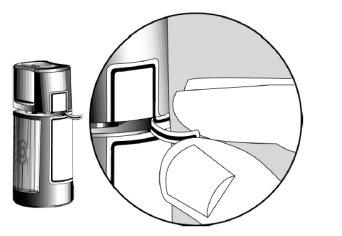
Простір ?
Місце для натискання
Пальцем ?
- Щоб відкрити пляшечку, поверніть кришку за вказівками стрілок на верхній частині кришки. Не тягніть кришку пляшечки прямо вгору. Тягнення кришки вгору завадить правильній роботі дозувального механізму.
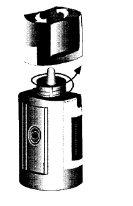
Місце для натискання
Пальцем ?
- Наклоньте голову назад і трохи відокремте нижню повіку, утворивши невеликий простір між повікою і оком.
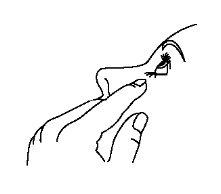
- Переверніть пляшечку і натисніть пальцем великим або вказівним на "Місце для натискання пальцем" (як показано на наступній фігурі) до тих пір, поки не буде виділена одна крапля згідно з інструкціями вашого лікаря.
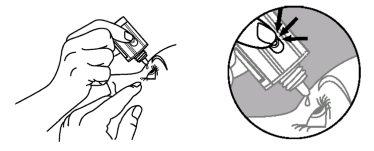
Місце для натискання
Пальцем
НЕ ДОТОРОНЬТЕ ОКОМУ АНІ ПОВІЦІ КІНЧИКОМ КРИШКИ.
- Після використання Тимофтолу натисніть пальцем на куточок ока біля носа (як показано на наступній фігурі) протягом 2 хвилин. Це допомагає утримувати Тимофтол в оці та запобігає поширенню тимололу в решту організму.
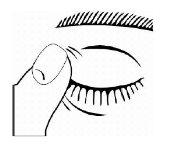
- Якщо після першого відкриття виділення краплі є складним, знову помістіть кришку і стисніть (НЕ ЗАБУДЬТЕ СТИСНУТИ ЦІЛКОМ) і потім зніміть кришку, повернувши її в протилежному напрямку, як вказано на стрілках на верхній частині кришки.
- Повторіть кроки 4 і 5 в іншому оці, якщо ваш лікар так вказав.
- Закрийте кришку, повернувши її, поки вона не торкнеться краю пляшечки. Для правильного закриття стрілка на лівому боці кришки повинна бути вишикована зі стрілкою на лівому боці етикетки пляшечки. Не стискуйте кришку надто сильно, оскільки це може пошкодити пляшечку і кришку.
- Кінчик дозувального механізму призначений для виділення однієї краплі; тому НЕ розширюйте отвір кінчика дозувального механізму.
- Після того, як ви використали всі дози, в пляшечці залишиться деяка кількість Тимофтолу. Не варто хвилюватися, оскільки було додано додаткову кількість Тимофтолу, і ви отримаєте всю кількість Тимофтолу, призначену вашим лікарем. Не намагайтеся виділити надлишок лікарського засобу з пляшечки.
Офтальмологічні лікарські засоби, якщо вони використовуються неправильно, можуть бути забруднені бактеріями, які можуть викликати інфекції в очах. Використання забруднених офтальмологічних розчинів може призвести до серйозних окулярних розладів та подальшої втрати зору. Якщо ви вважаєте, що ваш лікарський засіб може бути забрудненим або якщо у вас розвивається інфекція в оці, негайно проконсультуйтеся з вашим лікарем щодо подальшого використання цієї пляшечки.
Якщо ви використали більше Тимофтолу, ніж потрібно
Якщо ви використали більше Тимофтолу, ніж потрібно, негайно проконсультуйтеся з вашим лікарем або фармацевтом.
Найбільш поширені симптоми при передозуванні тимололом - це запаморочення, головний біль, коротке дихання, зниження частоти серцевих скорочень, зниження кров'яного тиску, серцева недостатність і/або зупинка серця.
У разі передозування або випадкового прийому лікарського засобу негайно проконсультуйтеся з вашим лікарем або фармацевтом або зверніться до служби токсикологічної інформації, телефон 91.562.04.20, вказавши назву лікарського засобу та кількість, яку ви використали.
Якщо ви забули використовувати Тимофтол
Не використовуйте подвійну дозу для компенсації пропущених доз.
Використовуйте Тимофтол згідно з схемою, яку вказав ваш лікар. Якщо ви забули одну дозу, застосуйте її якомога скоріше. Однак, якщо вже майже час наступної дози, проігноруйте пропущену дозу і поверніться до звичайної схеми застосування.
4. Можливі побічні ефекти
Як і всі лікарські засоби, Тімофтол може викликати побічні ефекти, хоча не всі люди їх відчувають.
Зазвичай ви зможете продовжувати використовувати краплі, якщо тільки побічні ефекти не будуть серйозними. Якщо ви турбуєтеся, проконсультуйтеся з вашим лікарем або фармацевтом. Не припиняйте використання Тімофтолу без попередньої консультації з лікарем.
При застосуванні тимололу офтальмологічним шляхом були спостережені наступні побічні ефекти:
Часті (можуть вплинути на до 1 з 10 пацієнтів):
- головний біль
- ознаки та симптоми очної іритації (напр., відчуття печіння, колючості, свербіння, кон'юнктивіт, сльозотеча, червоність), запалення повік, запалення рогівки, зниження чутливості рогівки та сухість очей
Рідкі (можуть вплинути на до 1 з 100 пацієнтів):
- депресія
- головокружіння, обморок
- розлади зору, такі як зміни рефракції
- сповільнений серцевий ритм (брадикардія)
- утруднення дихання (диспное)
- нудота, важке травлення (диспепсія)
- втома/знесиління
Рідкісні (можуть вплинути на до 1 з 1000 пацієнтів):
- ознаки та симптоми алергічних реакцій, включаючи ангіоневротичний набряк (набряк під шкірою в зонах, таких як обличчя та кінцівки, який може блокувати дихальні шляхи та викликати труднощі з ковтанням або диханням), кропив'янку або висипку з свербінням, локалізовану та загальну ерупцію, анафілаксію (важку алергічну реакцію, яка може загрожувати життю)
- безсоння (утруднення з сном), кошмари, втрата пам'яті
- чувство оніміння або м'язової слабкості, збільшення ознак та симптомів міастенії (м'язового захворювання), зниження статевого потягу (лібідо), інсульт (цереброваскулярна хвороба), ішемія головного мозку (зниження кровотоку до мозку)
- опущення верхнього повіка (залишення ока наполовину закритим), подвійне бачення (диплопія), відшарування хоріоідної оболонки (відшарування судинної оболонки під рогівкою після фільтраційної операції, яке може викликати порушення зору)
- шум у вухах (акуфен)
- грудний біль, серцебиття, набряк, нерегулярний серцевий ритм, серцева недостатність (хвороба, характеризована труднощами з диханням та набряком ніг і ступнів через накопичення рідини), блокада серця, зупинка серця
- низький артеріальний тиск, феномен Рейно (розлад судинної системи, який зазвичай впливає на пальці рук і ніг), біль або дискомфорт у кінцівці при початку ходьби, холодні руки та ноги
- утруднення дихання та звуження дихальних шляхів (переважно у пацієнтів з попередньо існуючою бронхо-спастичною хворобою), кашель
- діарея, сухість у роті
- втрата волосся, ерупція шкіри типу псоріазу або загострення псоріазу
- запальна хвороба з гарячкою, слабістю, больовістю суглобів та ушкодженнями шкіри (системний червоний лупус)
- хвороба Пейроні (яка може викликати виражену кривизну пеніса)
Частота невідома (не може бути оцінена на основі наявних даних):
- галюцинації
Як і інші лікарські засоби, що застосовуються в очах, тимолол проникає в кров. Це може викликати побічні ефекти, подібні до тих, які спостерігаються при застосуванні бета-блокаторів перорально або парентерально. Поява побічних ефектів при місцевому застосуванні в очах менш часта, ніж при пероральному або парентеральному застосуванні. Перелічені побічні ефекти включають ті, які були спостережені при застосуванні бета-блокаторів для лікування очних захворювань:
- Загальні алергічні реакції, включаючи набряк під шкірою в зонах, таких як обличчя та кінцівки, який може блокувати дихальні шляхи та викликати труднощі з ковтанням або диханням, кропив'янку або висипку з свербінням, локалізовану та загальну ерупцію, свербіння, важку алергічну реакцію, яка може загрожувати життю.
- Низький рівень глюкози в крові.
- Утруднення з сном (безсоння), депресія, кошмари, втрата пам'яті.
- Обморок, інсульт (цереброваскулярна хвороба), зниження кровотоку до мозку, загострення ознак та симптомів міастенії (м'язового захворювання), головокружіння, відчуття оніміння, такі як м'язова слабкість та головний біль.
- Ознаки та симптоми очної іритації (напр., печіння, колючість, свербіння, сльозотеча, червоність), запалення повіка, запалення рогівки, розмитість зору та відшарування хоріоідної оболонки під рогівкою після фільтраційної операції, яке може викликати порушення зору, зниження чутливості рогівки, сухість очей, ерозія рогівки (ушкодження передньої оболонки ока), опущення верхнього повіка (залишення ока наполовину закритим), подвійне бачення.
- Співільний серцевий ритм, серцебиття, грудний біль, набряк, зміни швидкості або ритму серцевих скорочень, серцева недостатність (хвороба, характеризована труднощами з диханням та набряком ніг і ступнів через накопичення рідини), деякі розлади серцевого ритму, блокада серця, зупинка серця
- Низький артеріальний тиск, феномен Рейно, холодні руки та ноги.
- Звуження дихальних шляхів (переважно у пацієнтів з попередньо існуючою хворобою), утруднення дихання, кашель.
- Порушення смаку, нудота, важке травлення, діарея, сухість у роті, біль у животі, блювота.
- Втрата волосся, ерупція шкіри типу псоріазу або загострення псоріазу, ерупція шкіри.
- М'язовий біль, не викликаний фізичними вправами.
- Сексуальна дисфункція, зниження статевого потягу.
- М'язова слабість/втома.
Звіт про побічні ефекти:
Якщо ви відчуваєте будь-який побічний ефект, проконсультуйтеся з вашим лікарем або фармацевтом, навіть якщо це можливі побічні ефекти, які не вказані в цьому листку. Ви також можете повідомити про них безпосередньо через Систему моніторингу лікарських засобів України: https://www.український веб-сайт.
Відправляючи повідомлення про побічні ефекти, ви можете допомогти надати більше інформації про безпеку цього лікарського засобу.
5. Зберігання ТІМОФТОЛУ
Тримайте цей лікарський засіб поза зоною досяжності дітей.
Не зберігайте при температурі вище 25 °C.
Зберігайте в оригінальній упаковці, щоб захистити від світла.
Не використовувати цей лікарський засіб після закінчення терміну придатності, вказаного на упаковці після абревіатури CAD.
Термін придатності - останній день місяця, вказаного на упаковці.
Викидайте через чотири тижні після відкриття упаковки.
Лікарські засоби не слід викидати в каналізацію або сміття. Віддавайте упаковки та лікарські засоби, які вам не потрібні, в пункт збору відходів аптеки. У разі сумнівів запитайте в вашого фармацевта, як позбутися упаковок та лікарських засобів, які вам не потрібні. Таким чином, ви допоможете захистити навколишнє середовище.
6. Зміст упаковки та додаткова інформація
Склад ТІМОФТОЛУ
- Активний інгредієнт - тимолол. Кожен мл Тімофтолу містить 6,8 мг малеату тимололу, що еквівалентно 5 мг тимололу
- Інші компоненти - дигідрогенфосфат натрію дигідрат, гідрогенфосфат динатрію додекагідрат, гідроксид натрію, хлорид бензалконію та вода для ін'єкційних препаратів.
Вигляд продукту та вміст упаковки
Тімофтол випускається у вигляді очних крапель у прозорому, безбарвному або жовто-червоному розчині.
Випускається в двох альтернативних упаковках:
- Упаковка з капельницею, яка містить 5 мл розчину.
- Офтальмологічний диспенсер Ocumeter Plus, який містить 3 мл розчину.
Можливо, тільки деякі розміри упаковок будуть випускатися.
Уповноважений на отримання дозволу на продаж та відповідальний за виробництво
Уповноважений на отримання дозволу на продаж
Santen Oy
Нііттюхаанкату 20
33720 Тампере
Фінляндія
Відповідальний за виробництво
Laboratoires Merck Sharp & Dohme
Chibret (“MIRABEL PLANT”)
Route de Marsat, RIOM
63963 Клермон-Ферран, Седекс 9, Франція
або
Santen Oy
Келлопортінкату 1
33100 Тампере
Фінляндія
Місцевий представник
Santen Pharmaceutical Spain S.L.
Acanto, 22, 7º
28045 – Мадрид
Іспанія
Дата останнього перегляду цього листка: Квітень 2020
Детальна та актуальна інформація про цей лікарський засіб доступна на сайті Державної служби України з лікарських засобів http://www.український веб-сайт.
- Країна реєстрації
- Діючі речовини
- Потрібен рецептТак
- Виробник
- Інформація є довідковою і не є медичною порадою. Перед прийомом будь-яких препаратів обов'язково проконсультуйтеся з лікарем. Oladoctor не несе відповідальності за медичні рішення, прийняті на основі цього контенту.
- Альтернативи до ТИМОФТОЛ 5 мг/мл КРАПЛІ ОЧНІ, РОЗЧИНФорма випуску: ОЧНІ КРАПЛІ, 5 мг/млДіючі речовини: timololВиробник: Immedica Pharma AbПотрібен рецептФорма випуску: ОФТАЛЬМОЛОГІЧНИЙ ГЕЛЬ, 1 мг/гДіючі речовини: timololВиробник: Sifi S.P.A.Потрібен рецептФорма випуску: ОЧНІ КРАПЛІ, 0,25%Діючі речовини: timololВиробник: Laboratorios Thea S.A.Потрібен рецепт
Аналоги ТИМОФТОЛ 5 мг/мл КРАПЛІ ОЧНІ, РОЗЧИН в інших країнах
Найкращі аналоги з тією самою діючою речовиною та терапевтичним ефектом.
Аналог ТИМОФТОЛ 5 мг/мл КРАПЛІ ОЧНІ, РОЗЧИН у Польша
Аналог ТИМОФТОЛ 5 мг/мл КРАПЛІ ОЧНІ, РОЗЧИН у Украина
Лікарі онлайн щодо ТИМОФТОЛ 5 мг/мл КРАПЛІ ОЧНІ, РОЗЧИН
Консультація щодо дозування, побічних ефектів, взаємодій, протипоказань та поновлення рецепта на ТИМОФТОЛ 5 мг/мл КРАПЛІ ОЧНІ, РОЗЧИН – за рішенням лікаря та згідно з місцевими правилами.






